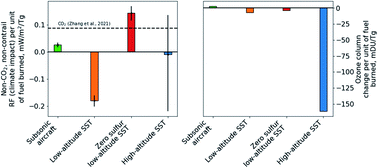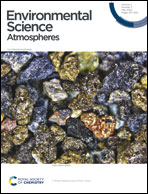Impacts of a near-future supersonic aircraft fleet on atmospheric composition and climate†
Abstract
Supersonic aircraft will have environmental impacts distinct from those of subsonic aviation, and are once again being developed and bought. Assessments of supersonic aircraft emissions impacts over the last decade have focused on the ozone and climate impacts of nitrogen oxides and water vapor, but assumed zero-sulfur fuel, zero black carbon emissions, and neglect likely design constraints on near-future engine technology. We assess the impacts on atmospheric composition and non-CO2 climate forcing of a near-future supersonic aircraft fleet with current-generation engine technology burning fossil-based kerosene fuel with current-day sulfur content. Using vehicle performance modeling, market demand projection and global atmospheric chemistry-transport modeling, we find that a supersonic fleet flying at Mach 1.6 and 15–17 km altitude, burning 19 Tg of fuel each year and emitting 170 Gg of NOx would cause a 0.046% reduction in global column ozone. We estimate the radiative forcing (climate impact) from changes in atmospheric concentrations of ozone (2.9 mW m−2), water vapor (1.3 mW m−2), carbonaceous and inorganic aerosols (−6.6 mW m−2), and methane (−0.65 mW m−2), resulting in a net non-CO2, non-contrail forcing of −3.5 mW m−2 and varying from −3.0 to −3.9 mW per m2 per year to year. We also show that the use of zero-sulfur fuel would halve net ozone depletion but increases the net non-CO2 non-contrail forcing to +2.8 mW m−2 due to the loss of a cooling effect from sulfate aerosols. A smaller fleet of Mach 2.2 aircraft flying at 18–20 km and burning 14 Tg of fuel but emitting twice as much NOx per unit of fuel results in 17 times as much net ozone depletion. The net radiative forcing for this fleet is of uncertain sign, averaging −0.15 mW m−2 but varying between −3.2 and +2.0 mW per m2 per year to year. Our results show that assessments of near-future supersonic aviation must consider the effects of fuel sulfur and black carbon alongside emissions of water vapor, NOx, and CO2, and that the net environmental impacts will be a trade-off between competing environmental concerns.

- This article is part of the themed collection: SDG13: Climate Action – Ozone Depletion


 Please wait while we load your content...
Please wait while we load your content...